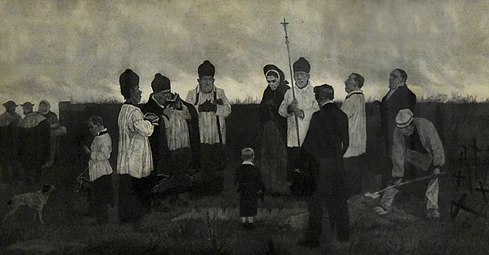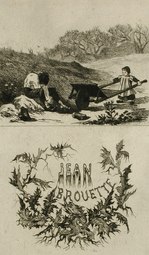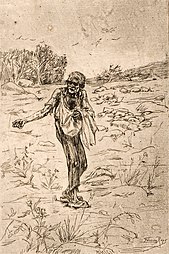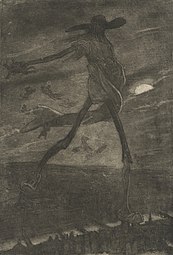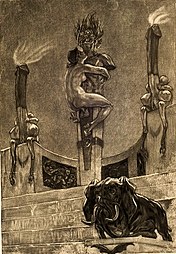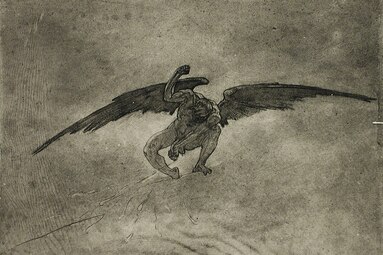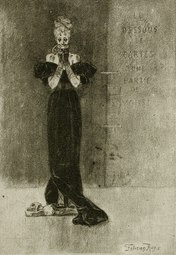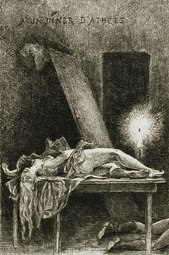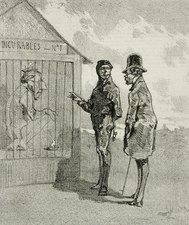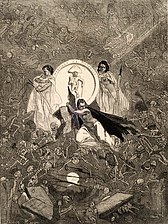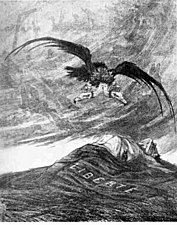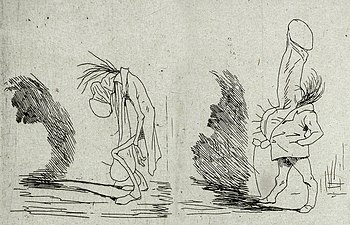Félicien Rops
Félicien Rops | |
|---|---|
Print making, intaglio, illustrations, drawing, painting | |
| Notable work | Pornocrates Les Sataniques Les Diaboliques |
| Movement | Symbolism, Decadent movement, Fin de siècle |
Félicien Victor Joseph Rops (7 July 1833 – 23 August 1898) was a Belgian artist associated with Symbolism, Decadence, and the Parisian fin de siècle. He was a painter, illustrator, caricaturist and a prolific and innovative print maker, particularly in intaglio (etching and aquatint). Although not well known to the general public, Rops was greatly respected by his peers and actively pursued and celebrated as an illustrator by the publishers, authors, and poets of his time. He provided frontispieces and illustrations for works by Jules Barbey d'Aurevilly, Charles Baudelaire, Charles De Coster, Théophile Gautier, Joris-Karl Huysmans, Stéphane Mallarmé, Joséphin Péladan, Paul Verlaine, Voltaire, and many others. Best known today for his prints and drawings illustrating erotic and occult literature of the period, he also produced oil paintings including landscapes, seascapes, and occasional genre paintings. Rops is recognized as a pioneer of Belgian comics.[1]: 243 p. [2][3][4]: 3-5 p.
Biography
Childhood and education (1833–1857)
Rops was born 7 July 1833 in Namur, Belgium, the only child of Sophie Maubile and Nicholas Rops. The Rops were a well-off bourgeois family, their wealth coming from textile manufacturing. Félicien was educated at his home by private tutors until the age of ten; then in 1843, he enrolled in a local Jesuit school for the next five years. His ability to recite lengthy passages from the Bible in Latin attest to both a good education and his intelligence, although even as a schoolboy it is reported that he had "begun to let fantasy dominate his thinking" and received complaints about "his passion for producing uninhibited caricatures of his teachers".[5]: 8 p. Nicholas Rops died in 1849. After some disagreements between Rops and his mother over the direction of his future education, a compromise was reached, and in June 1849 he enrolled at the Athénée secondary school in Namur while simultaneously attending the Academy of Fine Arts there.[2][4]: 22 p. [5]: 8 p. [6]
In 1851, Rops moved to Brussels and began studying law at the University of Brussels. However, by 1853, he was attending the Académie de Saint-Luc where he studied drawing and developed his skill as a draughtsman working from live models, meeting others like
Early career in Belgium, and marriage (1857–1870)

In June 1857, Rops married Charlotte Polet de Faveaux, the daughter of a wealthy magistrate and owner of Thozée Castle (see external links below) in the countryside near the town of Mettet, Belgium. For the first few years at Thozée, Rops enjoyed a comfortable life of a country gentlemen, pursuing passions for painting, botany, and even founding a rowing club in 1862, the Royal Nautical Club of Sambre and Meuse. He spoke highly of his father-in-law in his letters. Rops and his wife had a son, Paul, in 1858, and a daughter, Juliet, in 1859, who died at the age of five. Rops relinquished his managerial roll at Uylenspiegel but continued contributing cartoons and illustrations until 1862. He began to explore etching and produced political lithographs, occasional caricatures and cartoons for magazines, and frontispieces and illustrations for books. He illustrated a number of De Coster's books including Légendes Flamandes (1858), Contes Brabançons (1861) and La Légende d'Uylenspiegel ('Tijl Uilenspiegel', 1867). His home became a gathering place for artists, writers, publishers and friends. The Société Libre des Beaux-Arts (Free Society of Fine Arts) in Brussels was founded in 1868 and Rops served as Vice-President for several years. By the 1860s, Rops was traveling extensively and dividing his time between Thozée Castle, Namur, Brussels, and Paris each year; with ever extending time in Paris at the center of the art and literary world, and ever decreasing time at Thozée Castle and Namur with his wife and family as the decade passed.[1]: 243 p. [2][4]: 30 p. [5]: 9 p. [6][8]
In 1862, he studied etching with Félix Bracquemond and Jules Ferdinand Jacquemart in Paris and he became a restless experimenter with etching techniques. In later years, with his friend Armand Rassenfosse they developed a new soft ground varnish method which was dubbed "Ropsenfosse".[4]: 37 p. His activity as a lithographer had ceased by 1865, and although he continued oil painting, etching became his principal medium. He produced 34 frontispieces for books published between 1864 and 1870 and founded the short-lived International Society of Etchers (1869–1871).[1]: 243 p. [2][4]: 37 p. [5]: 9 p. [8]
Relationship with Charles Baudelaire (1862–1867)
Baudelaire wrote the following tribute to Rops:[4]: 3 p.
Use all your eloquence..../ To say how much I like / That bizarre Mr. Rops / Who may not be a Rome First Prize / But whose talent is as great / As the pyramids of Cheops.

Rops created the frontispiece for Baudelaire's Les Épaves (The Wreckage) and a selection of poems from Les Fleurs du mal (The Flowers of Evil) that had been censored in France, and were therefore published in Belgium. Rops first met Baudelaire's publisher Auguste Poulet-Malassis in 1862 and was later introduced to Charles Baudelaire towards the end of the poet's life. A friendship developed and Baudelaire visited the Rops family at Thozée Castle on many occasions and they traveled together on at least one occasion. In a letter (25 August 1886) discussing Baudelaire's writing, Rops wrote: "I lived with Baudelaire for two years. and often served him as a secretary, I never once saw him consult a dictionary. He didn't have any, and didn't want to have any...saying 'A man who looks up a word in a dictionary is like a conscript who, upon receiving the order to fire, looks for a cartridge in his pouch.'"[9]: 279 p. In a letter to Édouard Manet (11 May 1865) Baudelaire wrote, "Rops is the only true artist (in the sense in which I, and perhaps I alone, understand the word artist), that I have found in Belgium."[10]: 221 p. By 1866 Baudelaire and Poulet-Malassis were both in Belgium, in self-imposed exile evading creditors. Baudelaire stated that Rops and Poulet-Malassis were the only persons who "lightened [his] sadness in Belgium".[11]
It was while visiting Namur, in March 1866, that Baudelaire's first symptoms of
Baudelaire left an impression upon Rops that lasted until the end of his life. His association with Baudelaire and his illustrations of his poetry helped increase the visibility of his work and win the admiration of many other artists and writers, including
Later career in Paris (1871–1898)
The extended months in Paris away from his wife, and his poorly concealed extramarital affairs (described by his biographer Patrick Bade as his "careless contempt for bourgeois family values")[4]: 33 p. took a toll on Rops's marriage by the early 1870s. His wife Charlotte wrote to him in a letter: "Your latest despicable affair, the eighth since I met you and we were married, was your way of punishing others, you killed me! Since you don't want to see me any more and asked me not to write to you any more, I want my last word to you to be a word of pardon".[4]: 30 p. One of his mistresses—Alice Renaud, the woman referred to in his wife's letter—was murdered by her jealous husband a few years later, and Rops was involved in the scandal when his intimate love letters to her were read out loud at her husband's trial.[4]: 33 p. Although they never divorced, by 1875 Félicien and Charlotte were permanently estranged and Paris was to be his home for the remainder of his life.[4]: 30-33 p. [5]: 9 p.
However, far from being disheartened, he thrived among the Parisian artists and poets and his critical reputation grew. There was a greater demand than ever for his illustrations in the last quarter of the 19th century by the publishers and authors of the literary vanguard. Rops was prolific and achieved financial success, boasting in 1877 that "he was the best-paid illustrator in France."
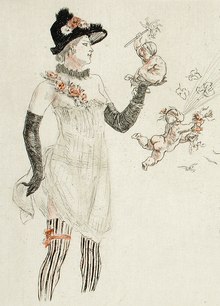
In the 1860s Rops had developed an acquaintance with a Madame Duluc and her two young daughters, Aurélie and Léontine Duluc (age 14 and 17 respectively at that time).[4]: 33 p. A few years later, not long before the estrangement from his wife, he began a ménage à trois with the sisters, apparently with their mother's endorsement. He had children with both, although one child died at an early age; the other, Claire, daughter of Léontine Duluc born in 1871, went on to marry the Belgian author Eugène Demolder. The Duluc sisters ran Maison Duluc, a successful fashion house in Paris, for which Rops designed logos and provided advertisements. The three traveled together to the United States and Canada on two occasions to present their fashions. At least one of the sisters served as a model on occasion, and one example was the figure illustrated in Georges Camuset's Sonnet du Docteur (The Sonnets of the Doctor; 1884). The three lived together for over 25 years until Rops's death. They ultimately settled in La Demi-Lune, a house he purchased, on the River Seine in Corbeil-Essonnes south of Paris, where Rops continued his passion for botany and developed new varieties of roses in later years. Aurélie and Léontine often combined their names, signing Auréléon in their letters and correspondence with Rops.[4]: 33-37 p. [5]: 10-11 p. [8][14][15]
Rops was invited to join
Due to an accident with "bichlorate of potassium"
There is now a Museum, Musée Félicien Rops, in his home town of Namur, Belgium, housing approximately 3,000 engravings and 500 drawings and paintings. Rops also was a gifted and prolific writer of letters. Referring to Rops,
Art

Art historians do not consider Rops a seminal figure of late 19th century art, even among the symbolists, and yet no creditable review of symbolism could ignore him either. Some of his critics dismiss him as a novel, 19th-century illustrator/pornographer, but others look beyond the erotica and write of him respectfully and favorably.[1]: 243 p. [2][18][19] He was regarded as the greatest Belgian artist of his time by Baudelaire (an influential art critic as well as a poet).[20] Jean-Luc Daval spoke of "the amazing upsurge of Symbolism that in the wake of Félicien Rops and under the influence of Gustave Moreau, characterized Belgian painting at the turn of the century."[21]: 105 p. According to Edith Hoffmann, the "erotic or frankly pornographic" nature of much of Rops's work "is at least partly due to the attraction these subjects had for a provincial artist who never forgot his first impressions of Paris".[6] In contrast to Hoffmann's "provincial artist", Octave Mirbeau wrote "Painter, man of letters, philosopher, scholar, Rops was all of that."[4]: 94 p.
Félicien Rops was a prolific and versatile artist. In addition to works of fine art depicting
French art critic and historian
Working in a long and rich tradition of Franco-Flemish realist-genre painting (e.g., the
Rops once wrote: "The love of brutal pleasures, the pre-occupation with money, and mean interests have glued onto the faces of most of our contemporaries, a sinister mask in which the perverse instinct mentioned by Edgar Allan Poe can be read in capital letters: all of this seems to me sufficiently amusing and characteristic that well-meaning artists should attempt to render the look of their time".[4]: 45 p.
According to H. R. Blakeley, "scholarship about Rops disproportionately fixates on the erotic aspects of his art, reductively classifying him as perversely misogynistic instead of investigating the complexities of his relationships with and attitudes about women."[18]
Painting and drawing
Rops's oil paintings are varied in subject and style. They include still life paintings, street scenes such as Entrance to the Ball, the Symbolist Death at the Ball, and many landscapes. He painted landscapes throughout his career, often small canvases done in
A small series of variations on a theme, The Lady with the Puppet includes four drawings with mixed media (watercolor, color pencil, pastel etc.) that were executed between 1873 and 1890. These symbolist works each show a woman, a "simple tart",[8] playing with a puppet (an allegory of man). In one, the woman unassumingly holds a blood-smeared trailing point at her side, with which she has slit the belly of the puppet open, and amusingly holds the puppet high as gold coins drain from his limp body.[8]
About 1878–1881 Rops produced a large series of over 100 pieces he called Cent légers croquis pour réjouir les honnêtes gens (A hundred lighthearted sketches without pretension to delight honest people) for a Parisian bibliophile, Jules Noilly. These were made in a variety of mixed media, mostly works on paper, including drawing, color pencil, watercolor, gouache, and pastel. Examples from the series include The Human Parody, The Librarian, L'Amour Mouché, Venus and Cupid-Love blowing his nose, and Cherub's Song.[4]: 38, 41, 42, 54, 75, & 82 pp. [8]
Gallery I: paintings and drawings
-
Entrance to the Ball (ca. 1858) Oil on canvas, mounted on board (29.5 x 21 cm) Musée Félicien Rops, Namur, Belgium
-
Death at the Ball (ca. 1865–1875) oil on canvas (150 x 85 cm) Kröller-Müller Museum, Netherlands
-
The Drunken Dandy (no date) mixed media on paper (39 x 48 cm) Musée Félicien Rops, Namur
-
Sailors Den (1875) watercolor, pastel, gouache (60.5 x 46.5 cm) Musée Félicien Rops, Namur
-
The Human Parody (1878–1881) watercolor, pastel, chalk (22.5 x 15 cm)
-
The Librarian, (1878–1881) pencil, watercolor, gouache (22 x 14.5 cm) Namur
-
L'Amour Mouché, Venus and Cupid-Love blowing his nose (1878–1881) mixed media (22 x 15) Musée Félicien Rops, Namur
-
In the wings (1878–1880) watercolor, colored pencil, and pastel (26 x 16.5 cm) Musée Félicien Rops, Namur, Belgium
-
Cherub's Song (1878–1881) watercolor, gouache, pastel, chalk (22 x 15 cm) Musée Félicien Rops, Namur
-
After Midnight, Returning makes you appreciate absence (no date) mixed media (22 x 15 cm) Private collection
-
Prehistoric Coupling (1887) color pencil, watercolor, gouache (30.5 x 23.6 cm.) Namur
-
Temptation of Saint Anthony (1878) mixed media (74 x 54) Royal Library of Belgium, Brussels
-
Untitled (no date) watercolor, colored pencil (22.9 x 28.6 cm) Metropolitan Museum of Art, New York
-
The Lady with the Puppet (ca. 1883–1885) mixed media (39.4 x 27.4 cm) Musée Félicien Rops, Namur
-
Paul Rops Sleeping (ca. 1872–75), oil on canvas (size unknown) Félicien Rops Fund, Namur, Belgium
-
Pears and Apple on a Plate (1882) oil on canvas (22,5 x 32 cm) Friends of the Musée Félicien Rops, Namur
-
The Rocks of the Grands Malades (1876) oil on canvas, Musée des Beaux Arts Ixelles
-
Snow in Thozée (no date) oil on canvas, Belfius Bank & Insurance, Brussels
-
The Pond of Bambois (1865) oil on panel (18.5 × 24 cm) Charleroi Museum of Fine Arts
-
More from Bambois (no date) oil on canvas, Musée Félicien Rops, Namur, Belgium
-
The Beach in Heist (1886) oil on canvas, Musée Félicien Rops Namen, Belgium
Prints and book illustrations
"Rops was a printmaker of brilliant technique and original content whose handling of dry point (etching directly on the plate) marks him as one of the masters of the medium."
Fascinated by the processes, he was constantly experimenting with printmaking techniques throughout his career. Starting around the early 1870s, Rops begin using soft-ground etching, a technique practiced by few artists of his day, often combining it with mezzotint, aquatint, dry point, and other techniques, sometimes adding hand-coloring to the plates. He photo-mechanically (
His etchings were popular and many of the progressive writers, poets, and publishers of late 19th-century literature sought out his talents for their publications. His prints were widely distributed in the books he illustrated and influenced many younger artists, including several
Gallery II: prints and book illustrations
-
Frontispiece for Les Épaves by Baudelaire (1868) etching (16 x 13,3 cm) Musée Félicien Rops, Namur
-
Frontispiece for The Supreme Vice by Peladan (1884) etching and aquatint (11.75 x 7.78 cm) Los Angeles County Museum of Art
-
Frontispiece for A Heart Lost by Peladan (1888) soft-ground etching (16.67 x 10.8 cm) Los Angeles County Museum
-
Frontispiece for Poésies by Mallarmé, The Lyre (1895) etching & drypoint (23 x 16 cm) L.A. Co. Museum
-
Frontispiece for Chair [Flesh] by Verlaine, Parallelism (ca. 1896) heliogravure (33.5 × 21.2 mm) The Art Institute of Chicago
-
Sainte-Thérèse (no date) heliogravure (15 x 11 cm) various locations.
-
Parisian Masks (no date) heliogravure (29.2 x 17.2 cm) Michael C. Carlos Museum, Emory University, Atlanta
-
Holocauste, Naturalia Non Sunt Turpia (What is natural is not dirty) (1895) heliogravure, drypoint (21.6 x 15.2 cm) Michael C. Carlos Museum, Emory University, Atlanta
-
Sentimental Initiation (1887) heliogravure, Michael C. Carlos Museum, Emory University, Atlanta
-
The Dance of Death (ca. 1865) etching (55 x 37 cm)
-
Flemish Madness (no date) aquatint (12.07 x 9.53 cm) Los Angeles County Museum of Art
-
Japanese Salamander and Beetle (no date) aquatint (9.21 x 6.67 cm) Los Angeles County Museum
-
The Cat [Amica Non Serva, Friend Not Servant] (no date) etching (8.26 x 5.87 cm) Los Angeles County Museum of Art
-
Separated or Simian Spring (no date) etching with aquatint (6.51 x 9.68 cm) Los Angeles County Museum of Art
-
The Absinthe Drinker (1853–1898) heliogravure (335 × 225 mm) Art Institute of Chicago
-
Mam'zelle Gavroche and Erotic Poetry (1879) heliogravure (24 x 18 cm) Michael C. Carlos Museum, Emory University, Atlanta
-
Celle qui fait 'Celle qui lit Musset' (1879) heliogravure (24.61 x 15.24 cm) Los Angeles County Museum of Art
-
A Shaker Pianist (1888) etching (16.99 x 11.75 cm) Los Angeles County Museum of Art
-
The Strike (1876) etching, drypoint (19.8 x 15.2 cm) Michael C. Carlos Museum, Emory University, Atlanta
-
Head of Zealander (1886) soft-ground etching (19.69 x 23.65 cm) Los Angeles County Museum of Art
-
Old Kate (1895) heliogravure & roulette (25.9 x 19.5 cm) Michael C. Carlos Museum, Emory University, Atlanta
-
Funeral in the Walloon Country (1863) lithograph, Musée Félicien Rops, Namen, Belgium
-
Jean Brouette (1875) etching (19.84 x 12.86 cm) Los Angeles County Museum of Art
-
Parable of the Sower (no date) heliogravure, drypoint (16.3 x 11.4 cm) Michael C. Carlos Museum, Emory University, Atlanta
-
The Kitchen of the Artists' Inn, in Anseremme (no date) etching (19.05 x 13.81 cm) Los Angeles County Museum of Art
Les Sataniques and Les Diaboliques
As early as 1896, when a special tribute edition of the literary journal
Les Sataniques (The Satanic) was a series of his own initiative, independent of his book illustrations and literary works. Dating from about 1882, there are a number of closely related drawings, watercolors, sketches, and other mixed media pieces, as well as prints in various states of development. He had hoped to do a large series and eventually publish them in the form of a book, but this never came to fruition. Ultimately a set of five
Gallery III: Les Sataniques
-
Satan Sowing Tares (1882) chromolithograph (30.4 x 21 cm) Musèe Félicien Rops
-
Satan Sowing Tare (1882) etching, aquatint (27.7 x 20.9 cm) National Gallery of Art, Washington, DC
-
The Abduction (1882) heliogravure (27.8 x 20 cm) Michael C. Carlos Museum, Emory University, Atlanta
-
Le Calvaire (1882) heliogravure (ca. 27 x 20 cm) Museum De Reede, Antwerp
-
The Idol (1882) heliogravure (27.6 x 20 cm) Michael C. Carlos Museum, Emory University, Atlanta
-
The Sacrifice (ca. 1882) soft ground etching, reproduced in heliogravure (27.6 x 20.3 cm) Metropolitan Museum of Art, New York
-
Satan Throwing to the World the Food She Deserves (no date) soft-ground etching (15.88 × 31.75 cm) Los Angeles County Museum of Art
-
Genesis from Les Sataniques (ca. 1882) soft-ground etching (18.89 x 25.56 cm) Los Angeles County Museum of Art
-
Satan Creating the Monsters from Les Sataniques (no date) soft-ground etching (13.1 x 19.6 cm) Los Angeles County Museum of Art
Rops wrote in a letter to Jean-François Taelemans (8 April 1886) that he was unsatisfied and the "small boards do not say anything".
The print of The Greatest Love of Don Juan bears a striking similarity to
Gallery IV:Les Diaboliques
-
Caricature of Barbey d'Aurevilly (no date) hand-colored lithograph (27.31 x 22.86 cm) Los Angeles County Museum of Art
-
The Sphinx, illustration forLes Diaboliques by Jules Barbey d'Aurevilly(1879) pencil & watercolor (25 x 18 cm) Brussels
-
The Sphinx (ca.1887-1893) heliogravure, soft-ground etching (11.75 x 7.94 cm) Los Angeles County Museum of Art
-
Prostitution and Madness Rule the World (ca.1887-1893) heliogravure, soft-ground etching (24 x 16 cm) L.A. County Museum of Art
-
The Crimson Curtain (ca. 1887–93) heliogravure, aquatint and soft varnish (23.7 × 16.5 cm) Art Institute of Chicago
-
The Greatest Love of Don Juan (ca. 1887–93) heliogravure, etching, drypoint, aquatinte (23.5 x 16.2 cm) Royal Library of Belgium
-
Happiness in Crime (ca. 1887–93) heliogravure, etching, dry point, aquatint (23.8 x 16.5 cm) Royal Library of Belgium
-
At a Dinner of Atheists (ca. 1887–93) heliogravure, aquatint, soft-ground varnish (24.8 x 16.6 cm) Royal Library of Belgium
-
Beneath the Cards in a Game of Whist (ca. 1887–93) heliogravure (24.2 x 16.3 cm) Los Angeles County Museum of Art
-
The Vengeance of a Woman (c. 1882–1886) etching (12.38 x 9.05 cm) Los Angeles County Museum of Art
-
Woman & Madness Rule the World (ca. 1887–93) heliogravure (24.2 x 16.3 cm) Los Angeles County Museum of Art
-
Happiness in Crime (1882) etching (12.38 x 9.05 cm) Los Angeles County Museum of Art
-
At a Dinner of Atheists, (1882–86) etching (12.38 x 8.73 cm) Los Angeles County Museum of Art
-
Beneath the Cards in a Game of Whist (ca. 1882–1886) etching (12.38 x 9.05 cm) Los Angeles County Museum of Art
Cartoons and caricatures
Félicien Rops was a pioneer and considered by many as the starting point for
Gallery V: cartoons and caricatures
-
The White Slave: The Casinos (Uylenspiegel, No. 11, 13 Apr. 1856) lithograph (30.16 x 22.7 cm) Los Angeles County Museum of Art
-
Galerie d'Uylenspiegel, Eduoard (Uylenspiegel, no. 5, 2 March 1856) lithograph (22.54 x 16.03 cm) Los Angeles County Museum of Art
-
Jardin Zoologique (Uylenspiegel, no. 20, 15 June 1856) lithograph (20.32 x 17.15 cm) Los Angeles County Museum of Art
-
Jardin Zoologique (Uylenspiegel, no. 28, 9 August 1857) lithograph) (28.58 x 20.64 cm) Los Angeles County Museum of Art
-
Maurice Voituron & Joseph Boniface), burgomaster of Uccle(1858) lithograph (28.58 x 19.53 cm) L.A. County Museum.
-
Médaille de Waterloo (1858) lithograph (58.2 x 43.6 cm) Michael C. Carlos Museum, Emory University, Atlanta
-
Political Comedy (1859) lithograph (23.65 x 18.89 cm) Los Angeles County Museum of Art of Art
-
Constitutional Chronicles (no date) lithograph (23.65 x 20 cm) Los Angeles County Museum of Art
-
The Last Incarnation of Vautrin (Uylenspiegel, No. 39, 2 Nov. 1862) lithograph (29.53 x 22.07 cm) Los Angeles County Museum of Art
-
Order Reigns in Warsaw (1863) lithograph (36.4 x 29.7)
-
The Right to Rest, The Right to Work (ca. 1868) etching (ca. 7.94 x 10.6 cm) Los Angeles County Museum of Art
-
Misanthropie! (1872) etching on Japan paper (19.37 x 15.08 cm) Los Angeles County Museum of Art
-
Parisian Life (1876) wood engraving (34.7 x 27.15 cm) Los Angeles County Museum of Art
-
Duluc Sisters, Dresses (no date) etching (7.62 x 5.56 cm) Los Angeles County Museum of Art I
References
- ^ a b c d e f g h i j k l Robert L. Delevoy (1978) Symbolists and Symbolism. Skira/Rizzoli International Publications, Inc., New York, 247 pp.
- ^ a b c d e f g h i j k l m n Jean Cassou (1979) The Concise Encyclopedia of Symbolism. Chartwell Books, Inc., Secaucus, New Jersey, 292 pp. [48, 94, 130-131 pp.]
- ^ a b Lambiek Comiclopedia: Félicien Rops. Entry by Kjell Knudde. https://www.lambiek.net/artists/r/rops_felicien.htm
- ^ a b c d e f g h i j k l m n o p q r s t u v w x Patrick Bade (2003) Félicien Rops. Parkstone Press Ltd, New York, 95 pp.
- ^ a b c d e f g h i j k l m n o Lee Revens and J.-K. Huysmans (1975) The Graphic Work of Félicien Rops. Léon Amiel Publisher, New York. 288 pp. [8-11 pp.]
- ^ a b c d e f Hoffmann, Edith, "Rops, Félicien", Oxford Art Online
- ^ Rops, Félicien, and Brison, Charles (1969). Pornocrates: an introduction to the life and work of Felicien Rops, 1833–1898. Skilton. p. 10.
- ^ a b c d e f g h i j k l m n o p q r s t Félicien Rops Biography. Musée Félicien Rops, Province de Numar. Accessed 12 September 2019 https://www.museerops.be/biographie
- ^ ISBN 0241 124581
- ^ a b c Lois Boe Hyslop and Francis E. Hyslop, Jr. (1957) Baudelaire: A Self-Portrait. Oxford University Press, London.
- ^ a b c Félicien Rops, Baudelaire and skeleton passions. British Library, European Studies Blog, 27 October 2014. Accessed 12 September 2019 https://blogs.bl.uk/european/2014/10/f%C3%A9licien-rops-baudelaire-and-skeleton-passions.html
- ^ a b Georges Poulet (1969) Who was Baudelaire? Editions d'Art Albert Skira, Geneva. 188 pp.
- ^ Paul Adam, Jean Moréas, and Félix Fénéon (1886) Petit Bottin de Letters et des Arts. E. Giraud & Co., Paris.
- ^ "Rops, Félicien". 21 March 2008. Retrieved 17 October 2011.
- ^ Huysmans, J-K. L’au-delà du mal ou l’oeuvre érotique de Félicien Rops. La Plume, No. 172: 15 juin 1896, p. 388-401.
- ^ Grand Orient du Belgiqua http://gob.be/ accessed 26 September 2019
- ^ Per Faxneld (2017). Satanic Feminism: Lucifer as the Liberator of Woman in Nineteenth-Century (Oxford Studies in Western Esotericism). Oxford University Press, New York, 576 pp.[286 p.] eISBN 978-0-19-066449-7
- ^ a b c d e f g Blakeley, H. R. (2015) Beyond Eros: Works by Félicien Rops in the Michael C. Carlos Museum. Carlos Museum and Emory’s Center for Digital Scholarship, Emory University, Atlanta. Accessed 23 September 2019 https://rops.digitalscholarship.emory.edu/exhibits/show/felicien-rops
- ^ a b Encyclopaedia Britannica (2019) Félicien Rops, Belgian Artist. (last update: 18 Aug 2019) accessed 16 October 2019
- ^ Thomson, Richard (2000). Felicien Rops, Rops-suis-aultre-ne-veult-estre.". Print Quarterly 17(4): 427–429.
- ISBN 0-8478-0212-4
- ISBN 0-399-11039-9
- ISBN 0-8478-0047-4.
- ISBN 978-0-19-531391-8.
- ^ Josef von Sternberg, (1966) Fun in a Chinese Laundry. Martin Secker & Warburg Ltd, London, 348.[231-232 pp.]
- ISBN 0-520-06776-2
- ISBN 0-8076-0840-8.
- ISBN 978-3-7913-4094-4
- ^ a b c d e Alric Delaporte (2014) Les Diaboliques de Félicien Rops. Master Thesis, University of Paris, Panthéon-Sorbonne. https://hicsa.univ-paris1.fr/documents/file/JE%20Meneux%20Master%202014/3-Delaporte-Diaboliques%20Rops.pdf
- ^ a b Nicolas Valazza (with S. N. Rosenberg, L. Lerme & H. (2019) Banned Books and Prints in Europe and the United States, 17th–20th Centuries. Works from the Lilly Library and the Kinsey Institute Collections. Indiana University Bloomington https://bannedbooks.indiana.edu/exhibits/show/bannedbooks/prose--france--19th-century
- ^ a b Arne Eggum (1978) Edvard Munch: Symbols and Images. National Gallery of Art, Washington D.C. 264 pp.
- ^ Przybyszewski, Stanislaw, editor (1894). Das Werk des Edvard Munch. Published by S. Fischer Verlag, Berlin. With contributions by Stanislaw Przybyszewski, Franz Servaes, Willy Pastor, Julius Meier-Graefe.
- ^ Messer, Thomas M. (1970). Munch: The Library of Great Painters. Harry N. Abrams, Inc., Publishers, New York. 166 pp. [page 35]
- ^ Prelinger, Elizabeth and Michael Parke-Taylor(1996). The Symbolist Prints of Edvard Munch. Yale University Press, New Haven and London, 236 pp.
Further reading
- P. & V. Berko, "Dictionary of Belgian painters born between 1750 & 1875", Knokke 1981, p. 565–566.
- P. & V. Berko, "19th Century European Virtuoso Painters", Knokke 2011, p. 513, illustrations p. 145.
External links
- The Musée Félicien Rops in Namur (English, French)
- Rops correspondence at Mount Holyoke College Archived 13 December 2013 at the Wayback Machine
- Works by Félicien Rops at Project Gutenberg
- Works by or about Félicien Rops at Internet Archive
- Felicien Rops at the Internet Speculative Fiction Database
- Blakeley, H. R. (2015) Beyond Eros: Works by Félicien Rops in the Michael C. Carlos Museum. Carlos Museum and Emory's Center for Digital Scholarship, Emory University, Atlanta. Accessed 23 September 2019 Beyond Eros: Works by Félicien Rops in the Michael C. Carlos Museum · Félicien Rops
- Félicien Rops Letters, [1]
- Musée Félicien Rops [Félicien Rops Museum] Musée Félicien Rops – Musée d'Art du 19e – à Namur
- Bienvenue au château de Thozée! - Welcome to Château de Thozée! (Accessed 30 December 2019)
- Church of Saint-Loup at Namur. Wikimedia Commons, Category: Église Saint-Loup, Namur (Accessed 30 December 2019)











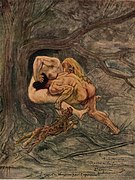







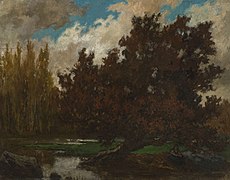






![Frontispiece for Chair [Flesh] by Verlaine, Parallelism (ca. 1896) heliogravure (33.5 × 21.2 mm) The Art Institute of Chicago](http://upload.wikimedia.org/wikipedia/commons/thumb/e/ed/Felicien_Rops%2C_Parallelism_%28ca._1896%29_heliogravure_%2833.5_%C3%97_21.2_mm%29_The_Art_Institute_of_Chicago.jpg/162px-Felicien_Rops%2C_Parallelism_%28ca._1896%29_heliogravure_%2833.5_%C3%97_21.2_mm%29_The_Art_Institute_of_Chicago.jpg)







![The Cat [Amica Non Serva, Friend Not Servant] (no date) etching (8.26 x 5.87 cm) Los Angeles County Museum of Art](http://upload.wikimedia.org/wikipedia/commons/thumb/6/6b/Felicien_Rops%2C_The_Cat%2C_Amica_Non_Serva%2C_Friend_Not_Servant_%28_no_date%29_etching_%288.26_x_5.87_cm%29_Los_Angeles_County_Museum_of_Art.tif/lossy-page1-174px-Felicien_Rops%2C_The_Cat%2C_Amica_Non_Serva%2C_Friend_Not_Servant_%28_no_date%29_etching_%288.26_x_5.87_cm%29_Los_Angeles_County_Museum_of_Art.tif.jpg)








